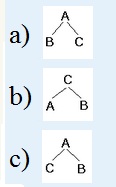Tskafli8

Spurningar úr kaflanum: (kafli 8)
- 1.
Suppose a binary tree contained the nodes W,X,Y and Z. If W and X were children of Y and Z had no children, which node would be the root?
- A.
Y
- B.
X
- C.
Z
- D.
W
Correct Answer
A. Y -
- 2.
Suppose you were going to retrieve items of data that you would later need to process in the opposite order from that in which they were retrived. Which of the following would be the best structure in which to store the items?
- A.
Traditional linked list
- B.
Stack
- C.
Tree
- D.
Queue
Correct Answer
B. Stack -
- 3.
If the two-dimensional array X were stored in row-major order, then in the block of main mermory containing X, which of the following would be true?
- A.
The entry X[1,2] would be in the same location as X[2,1]
- B.
The entry X[1,2] would be appear before X[2,1]
- C.
The entry X[1,2] would appear after X[2,1]
- D.
None of the above
Correct Answer
B. The entry X[1,2] would be appear before X[2,1] -
- 4.
If the longest path in a binary tree contained exactly four nodes, what is the maximum number of nodes that could be in that entier tree?
- A.
31
- B.
7
- C.
15
- D.
4
Correct Answer
C. 15 -
- 5.
In a machine language, the technique in which the data to be manipulated by an instruction is included within the instruction itself is called…
- A.
Direct adressing
- B.
Indirect adressing
- C.
Immediate addressing
Correct Answer
C. Immediate addressing -
- 6.
Which of the following is a LIFO structure?
- A.
Stack
- B.
Queue
- C.
Tree
- D.
Array
Correct Answer
A. Stack -
- 7.
If the number of nodes in a binary tree is 2^n (where n is a positive integer), then the entire tree would contain at least
- A.
2^n+1 -1 nodes
- B.
2^n+1 nodes
- C.
2^n+2 nodes
- D.
2^2n nodes
Correct Answer
A. 2^n+1 -1 nodes -
- 8.
The nodes in which of the trees below will be printed in alphabetical order by the following recursive procedure? procedure printTree (Tree) if(Tree is not empty) then (apply the procedure printTree to the left subtree of Tree; apply the procedure printTree to the right subtree of Tree; print the root node) Veldu eitt:
- A.
A)
- B.
B)
- C.
C)
Correct Answer
B. B) -
- 9.
Which of the following is a FIFO Structure?
- A.
Array
- B.
Queue
- C.
Stack
- D.
Tree
Correct Answer
B. Queue -
- 10.
If a stack contained the entries w,x, y, z (from top to bottom), which of the following would be the contents after two enteries were removed and the the entry r was inserted?
- A.
R, y, z
- B.
R, w, x
- C.
W, x, r
- D.
Y, z, r
Correct Answer
A. R, y, z -
- 11.
- A.
A.
- B.
B.
- C.
C.
- D.
None of the above
Correct Answer
B. B. -
- 12.
Which of the following is not used when determining the location of an entry in a two-dimentional homogeneous array stored in row-major orderd?
- A.
Number of rows in the array
- B.
Number of columns in the array
- C.
Indices
- D.
Address polynomial
Correct Answer
A. Number of rows in the array -
Quiz Review Timeline +
Our quizzes are rigorously reviewed, monitored and continuously updated by our expert board to maintain accuracy, relevance, and timeliness.
-
Current Version
-
Oct 28, 2013Quiz Edited by
ProProfs Editorial Team -
Nov 28, 2012Quiz Created by
Viddz1
 Back to top
Back to top



